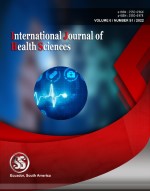Comparison of conventional incision and drainage versus ultrasound guided minimally invasive techniques in management of the breast abscess
A prospective cohort study
Keywords:
breast abscess, usg guided needle aspiration, suction drain, minimally invasive techniquesAbstract
Background: The feasibility of ultrasound guided minimally invasive techniques in management of breast abscess has been a topic of concern from a long time thus, resulting in many studies. Objectives: To assess the feasibility and to compare ultrasound guided minimally invasive techniques with conventional incision and drainage in breast abscess management Materials and Methods: Patients admitted in Surgery Department / OPD with BREAST ABSCESS (total 60 patients) were divided into two random groups of 30 patients each using random number tables. Group 1 was treated by conventional incision and drainage, Group 2 was treated by ultrasound guided minimally invasive techniques. Chi-square test was used. Results: For group 2, the average pain(VAS) score was 4.7 with minimal bleeding during the procedure, no need of dressing, average duration of stay 0.47 days, average days required for complete recovery is 13 days and excellent cosmesis as compared to group 1 where average pain score was 7, mild bleeding occurred in all cases with requiring an average of 10 days of dressing, all healed leaving a scar, average days required for complete recovery is 28 days and thus only satisfactory cosmesis with average 3.1 days of hospital stay.
Downloads
References
Martin JG. Breast abscess in lactation. Journal of midwifery and women's health. 2009;54(2):150-1.
Leibman AJ, Misra M, Castaldi M. Breast abscess after nipple piercing: sonographic findings with clinical correlation. Journal of Ultrasound in Medicine. 2011;30(9):1303-8.
Walker AP, Edmiston CE, Krepel CJ, Condon RE. A prospective study of the microflora of nonpuerperal breast abscess. Archives of surgery. 1988;123(7):908-11.
Brook I. Microbiology of non-puerperal breast abscesses. The Journal of infectious diseases. 1988;157(2):377-9.
Kataria K, Srivastava A, Dhar A. Management of lactational mastitis and breast abscesses: Review of current knowledge and practice. Indian Journal of Surgery 2013;75(6):430-5.
Benson EA. Management of breast abscesses. World Journal of Surgery. 1989; 13:753-6.
Webster DJ. Infections of the breast. In: Hughes LE, Mansel RE, Webster DJ, editors. Benign disorders and diseases of the breast. WB saunders: London; 2000. p.190.
Karstrup S, Solvig J, Nolsoe CP, Nilsson P, Khattar S, Loren I, Nilsson A, Court-Payen M. Acute puerperal breast abscesses: US-guided drainage. Radiology. 1993;188(3):807-9.
Hayes R, Michell M, Nunnerley HB. Acute inflammation of the breast—the role of breast ultrasound in diagnosis and management. Clinical Radiology. 1991;44(4):253-6.
Tewari M, Shukla HS. An effective method of drainage of puerperal breast abscess by percutaneous placement of suction drain. Indian J Surg. 2006;68(6):330-3.
Odiya S, Mathur R, Arora S. Comparative study of conventional incision and drainage versus percutaneous placement of suction drain: changing trend of breast abscess management. International Surgery Journal. 2016;3(3):1580-4.
Chandika AB, Gakwaya AM, Kiguli-Malwadde E, Chalya PL. Ultrasound guided needle aspiration versus surgical drainage in the management of breast abscesses: A Ugandan experience. Biomed Central Research Notes 2012;5(12): 1-7.
Dabbas N, Chand M, Pallett A, Royle GT, Sainsbury R. Have the Organisms that Cause Breast Abscess Changed With Time?––Implications for Appropriate Antibiotic Usage in Primary and Secondary Care. The breast journal. 2010;16(4):412-5.
Ulitzsch D, Nyman MK, Carlson RA. Breast abscess in lactating women: US-guided treatment. Radiology. 2004;232(3):904-9.
Berna-Serna JD, Madrigal M. Percutaneous management of breast abscesses. An experience of 39 cases. Ultrasound in medicine & biology. 2004;30(1):1-6.
Published
How to Cite
Issue
Section
Copyright (c) 2022 International journal of health sciences

This work is licensed under a Creative Commons Attribution-NonCommercial-NoDerivatives 4.0 International License.
Articles published in the International Journal of Health Sciences (IJHS) are available under Creative Commons Attribution Non-Commercial No Derivatives Licence (CC BY-NC-ND 4.0). Authors retain copyright in their work and grant IJHS right of first publication under CC BY-NC-ND 4.0. Users have the right to read, download, copy, distribute, print, search, or link to the full texts of articles in this journal, and to use them for any other lawful purpose.
Articles published in IJHS can be copied, communicated and shared in their published form for non-commercial purposes provided full attribution is given to the author and the journal. Authors are able to enter into separate, additional contractual arrangements for the non-exclusive distribution of the journal's published version of the work (e.g., post it to an institutional repository or publish it in a book), with an acknowledgment of its initial publication in this journal.
This copyright notice applies to articles published in IJHS volumes 4 onwards. Please read about the copyright notices for previous volumes under Journal History.
















